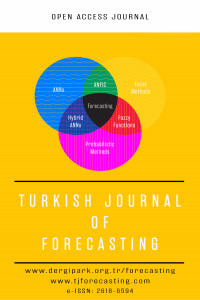Estimating CO2 Emission Time Series with Support Vector Machines Regression, Artificial Neural Networks, and Classic Time Series Analysis
Estimating CO2 Emission Time Series with Support Vector Machines Regression, Artificial Neural Networks, and Classic Time Series Analysis
Artificial intelligence machine learning has become very popular in recent years. It offers the ability to combine machine learning theory with many analyses such as classification, prediction models, natural language processing. Carbon dioxide emission is defined as the release of carbon, often caused by human nature, into the atmosphere. In the 19th century, the industrial revolution took place and the use of coal-powered industrial vehicles increased the amount of carbon released into the atmosphere. These gases released into the atmosphere have brought climate problems in proportion to the increase in temperature. Because of climate problems, the sweet water source of the earth’s ice pack continues to melt and the sea level rises. Therefore, the amount of carbon dioxide emission (metric tons per person) Artificial Neural Networks (ANN), Support Vector Machines Regression (SVMR), estimated by Box-Jenkins technique based on time series analysis and estimated estimates compared to MSE (mean square error) between 1990-2018. The comparison found that the Artificial Neural Networks have better predictive results on the SVMR and Box-Jenkins technique on the performance benchmark.
___
- [1] Ramanathan , R. (2006), “A multi-factor efficiency perspective to the relationships among world GDP, energy consumption and carbon dioxide emissions”, Technological Forecasting and Social Change, 483-494.
- [2] Keskingöz, Hayrettin, Karamelikli, Hüseyin, (2015), "Dış Ticaret-Enerji Tüketimi ve Ekonomik Büyümenin CO2 Emisyonu Üzerine Etkisi", Kastamonu Üniversitesi İktisadi ve İdari Bilimler Fakültesi Dergisi 9(3), 7-17 .
- [3] Chang,N. (2015), “Changing industrial structure to reduce carbon dioxide emissions: a Chinese application”. Journal of Cleaner Production, 40-48.
- [4] Pabuçcu, Hakan , Bayramoğlu, Turgut, (2016), "Yapay Sinir Ağları İle CO2 Emisyonu Tahmini: Türkiye Örneği". Gazi Üniversitesi İktisadi ve İdari Bilimler Fakültesi Dergisi, 18(3), 762-778.
- [5] İnce, H., ve İmamoğlu, S. (2016). Destek vektör regresyon ve ikiz destek vektör regresyon yöntemi ile tedarikçi seçimi. Doğuş Üniversitesi Dergisi, 17(2), 241-253.
- [6] Chen Z, Ye X, Huang P. (2018), “Estimating Carbon Dioxide (CO2) Emissions from Reservoirs Using Artificial Neural Networks. Water. 2018, 10(1):26.
- [7] Chiu, Y., Jiang,P. etc. (2020), “A Multivariate Grey PredictionModel Using Neural Networks with Application to Carbon Dioxide Emissions Forecasting”. Hindawi.
- [8] Keskin, A. (2020), “G20 Ülkelerinin CO2 Emisyonları ve Kişi başına Düşen Milli Gelirin 1960-2012 Dönemi Arasındaki Ampirik Analizi”, Medeniyet Araştırmaları Dergisi, 5(1) , 25-38 .
- [9] Açıkkar M., Sivrikaya O., (2020), “ Yıkanmış Türk Linyit Kömürlerinin Üst Isıl Değerinin Destek Vektör Regresyonu ile Tahmini”, Avrupa Bilim ve Teknoloji Dergisi. 2020,(18), 16-24.
- [10] Haykin, S., (1999), “Neural Networks: A Comprehensive Foundation. 2nd Edition, Prentice- Hall, Englewood Cliffs, NJ.
- [11] Özalp A., Anagün S., (2003). Yapay Sinir Ağı Performansına Etki Eden Faktörlerin Analizinde Taguchi Yöntemi: Hisse Senedi Fiyat Tahmini Uygulaması”, İstatistik Araştırma Dergisi, Yıl: 2, Sayı: 1.
- [12] Akpınar M.,(2017), “İstatistik Ve Yapay Zeka Teknikleri İle Enerji Tüketiminin Tahmini: Sakarya Doğal Gaz Tüketiminin Uygulaması”, Doktora Tezi,Sakarya Üniversitesi Fen Bilimleri Enstitüsü.
- [13] Uçak, K., ( 2012) “Destek Vektör Regresyonu ile Pid Kontrolör Tasarımı”. İstanbul Teknik Üniversitesi, Fen Bilimleri Enstitüsü, Yüksek Lisans Tezi, 89s.
- [14] Bilişik, M. T. (2011), “Destek Vektör Makinesi, Çoklu Regresyon ve Doğrusal Olmayan Programlama ile Perakendecilik Sektöründe Gelir Yönetimi İçin Dinamik Fiyatlandırma”. İstanbul: XI Üretim Araştırmaları Sempozyumu.
- [15] Walgampaya C., Kantardzic M. Selection of Distributed Sensors for Multiple Time Series Prediction”, The 2006 IEEE International Joint Conference on Neural Network Proceedings.2006.
- [16] Özmen, A. (1986), “Zaman serisi analizinde Box- Jenkins yöntemi ve banka mevduat tahmininde uygulama denemesi”.Kitap. Anadolu Üniversitesi Yayınları 207. Fen Edebiyat Fakültesi Yayınları No: 9.
- [17] Karahan, M. (2011), “İstatistiksel Tahmin Yöntemleri: Yapay Sinir Ağları Metodu ile Ürün Talep Tahmini Uygulaması”. Yayınlanmamış Doktora Tezi. Konya: Selçuk Ü. Sosyal Bilimler Enstitüsü.
- [18] Tozkan, S., (2004) “Yapay Sinir Ağları”, Fırat Üniversitesi Mühendislik Fakültesi Elektrik Elektronik Mühendisliği Bölümü Bitirme Ödevi.
- [19] Adamowski, J. F. (2008), “Peak Daily Water Demand Forecast Modeling Using Artificial Neural Networks”, Journal of Water Resources Planning And Management, 134(2), 119-128.
- [20] Bougadis, J., Adamowski, K., Diduch, R. (2005), “Short-Term Municipal Water Demand Forecasting”,Hydrological Processes. 19, 137–148.
- [21] Msiza, I. S., Nelwamondo, F. V., & Marwala, T. (2007), “Water Demand Forecasting Using Multi-layer Perceptron and Radial Basis Functions”. Proceedings of International Joint Conference on Neural Networks, Orlando, Florida, USA. August, 12-17.
- [22] Jain, A., Varshney, A. K., Joshi, U.C., (2001), “Short-Term Water Demand Forecast Modelling at IIT Kanpur Using Artificial Neural Networks. Water Resources Management. 15, 299-321.
- Yayın Aralığı: Yılda 2 Sayı
- Başlangıç: 2017
- Yayıncı: Giresun Üniversitesi
